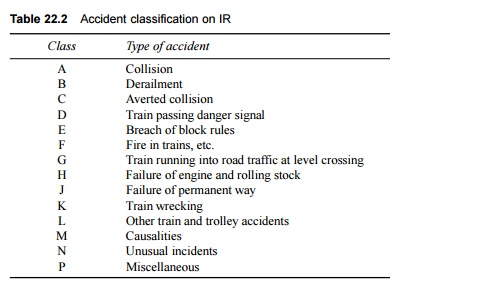Chapter: Civil : Railway Airport Harbour Engineering : Railway Engineering : Railway Accidents and Disaster Management
Classification of Railways Accidents
Classification of Railways Accidents
Railway accidents are categorized into different classes according
to the type of accident (Table 22.2).

Out of the accidents listed in
Table 22.2, the more important ones are discussed in detail in the following
subsections.
Collisions
Collision refers to one train
crashing or running into another train or rolling stock. These type of
accidents are dreaded the most, and though they constitute only 7% of all
accidents, they are responsible for 38% of the total number of deaths. There
are three major types of collisions, namely, head-on collisions, rear-end
collisions, and side collisions. The main causes behind these collisions are
failure of the station staff or technical staff to carry out their duties
effectively and failure of drivers due to a communication error. The remedial
measures for avoiding collisions are as follows.
(a) Development
of human resources
(b) Modern
signalling technologies and electronic gadgets: The new technologies adopted to
compensate for the error of human judgement mostly consist of improved
signalling methods and innovative electronic systems. Some of these
technologies include automatic block signalling and continuous
track-circuiting, automatic train protection and warning systems, block proving
by axle counters, panel and solid-state interlocking, and the anti-collision
device (ACD). These systems send out a timely warning or automatically apply
brakes to prevent an accident even in the case of human failure.
Derailments
A derailments occurs when a train skids off the track because
of some obstruction or abnormality. The main causes of derailments are track
defects, vehicle defects, signalling and interlocking defects, human failure
including defective operation of railway equipment, and other miscellaneous
causes. The remedial measures for preventing derailments are follows.
(a) Improvement
in track structure and track maintenance procedures
(b) Use of a
modern rolling stock with planned maintenance schedules
(c) Use of
modern signalling and electronic equipment with innovative techniques
(d) Development
of human resources
Accidents at level crossings
Out of the 37,345 level crossings
existing on Indian Railways as on 31 March 2004, only 16,607 level crossings
were manned and had gatekeepers; the rest were unmanned and did not have gatekeepers.
Only 14,500 level crossings had telephone systems connected them to the
stations.
Fire accidents in trains
Train fires, particularly fires
in passenger trains, take a heavy toll on life and property. These fires may
occur due to a short circuit in the wiring of the coaches, the presence of
inflammable material such as petrol, kerosene oil, and gas cylinders inside the
trains, etc. The following measures have been taken to avert train fires.
Design of coaches Wooden
coaches have been replaced with steel coaches and the inside of the
coaches are gradually being equipped with fire-resistant materials.
Electric lighting The
railways have switched over from gas lighting to electric lighting. Even
in this case, a short circuit in the 24-V system, which draws a heavy current,
can cause the electric wires to get overheated resulting in a fire in the
coach. In view of this danger, Indian Railways is gradually changing the system
to that of 110 V, of which will reduce the possibilities of such fires.
Publicity campaigns Even
though the railways have strict rules regarding the transportation of
explosives and dangerous materials, these rules need to be implemented more
rigorously. The railways are introducing new publicity campaigns to educate the
public in this regard.
Accidents due to floods and breaches
Railway bridges and embankments
are likely to get adversely affected, due to heavy rains and sudden cloudbursts
that result in floods and breaches, thereby creating unsafe conditions on the
tracks and causing accidents. Therefore, the following safety measures should
be taken during heavy rains to ensure the safety of the track.
(a) Gang
patrolling during an abnormal rainfall or storm to check damages if any, to the
track and bridges.
(b) Night
patrolling during monsoons to detect the damages if any, caused by floods,
including breaches, settlements, slips, and scours, and taking immediate action
on perceiving any damage so as to protect the trains.
(c) Daily
foot patrolling by the keyman to inspect the entire track. The keyman should
also take immediate action upon discovering any unsafe condition that may be a
result of unexpected occurrences such as rains and floods.
(d) Watchmen
should be stationed at all vulnerable locations such as bridges and flooded
causeways in order to provide safety to railway tracks.
Related Topics